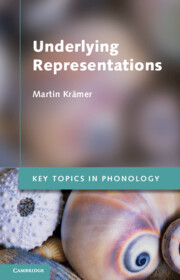Book contents
- Frontmatter
- Contents
- Acknowledgements
- Abbreviations
- 1 Getting started
- 2 Arbitrariness and opposition
- 3 Derivation and abstractness
- 4 Underspecification returns
- 5 The devil is in the detail
- 6 Psycho- and neurolinguistic evidence
- 7 On the form and contents of contrastive features
- 8 Underlying representations in Optimality Theory
- 9 Preliminary results
- Glossary
- Notes
- References
- Name index
- Language index
- Subject index
- References
4 - Underspecification returns
Published online by Cambridge University Press: 05 November 2012
- Frontmatter
- Contents
- Acknowledgements
- Abbreviations
- 1 Getting started
- 2 Arbitrariness and opposition
- 3 Derivation and abstractness
- 4 Underspecification returns
- 5 The devil is in the detail
- 6 Psycho- and neurolinguistic evidence
- 7 On the form and contents of contrastive features
- 8 Underlying representations in Optimality Theory
- 9 Preliminary results
- Glossary
- Notes
- References
- Name index
- Language index
- Subject index
- References
Summary
INTRODUCTION
In Chapter 3 we found that the omission of feature values in underlying representations became discredited by the end of the 1960s. Underspecification in the form of zeroes or blanks (rather than u and m markings) had a revival in the 1980s, which came in two flavours: Contrastive Underspecification (Steriade 1987, 1995, Clements 1988) and Radical Underspecification (Kiparsky 1982, Archangeli 1984, 1985, 1988, Pulleyblank 1986). The main point of disagreement between the two approaches lay in the question of how to determine feature values and whether this could be done on a language-specific basis or had to follow universal principles, i.e., make use of universally valid feature-filling rules and constraints. A third approach to underspecification, the deduction of feature specifications (and lack thereof) on the basis of a Contrastive Hierarchy, reappeared in the late 1990s and the following decade with the work of Dresher and his associates (Dresher 2003, 2008, 2009, 2010 and references there). We have seen such a hierarchy or division tree in the discussion of Trubetzkoy in Chapter 2 and it had been a common tool in generative phonology in the 1950s, e.g., in Halle (1959).
The 1980s also saw a renewed interest in unary or privative features, which we also have met in passing in the section on Trubetzkoy’s work (Section 2.3). A privative feature is either present or absent rather than taking a value. Thus, zero is one of two options rather than one of three and the adoption of privative features renders large parts of the discussion around underspecification obsolete. However, the issue does not vanish completely. If we take, for instance, the feature [voice], which has been argued to be privative by Lombardi (1991) and others, we see that underspecification is still an option. While in a language contrasting /p,t,k/ with /b,d,g/ the voiceless series is now necessarily underspecified, the sonorants in the same language, which are redundantly voiced at the surface, could be specified as [voice] underlyingly for the sake of completeness or lack this feature because it is redundant.
- Type
- Chapter
- Information
- Underlying Representations , pp. 65 - 97Publisher: Cambridge University PressPrint publication year: 2012



